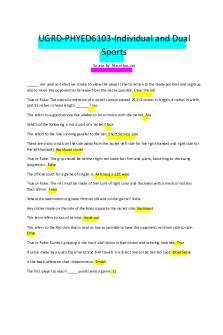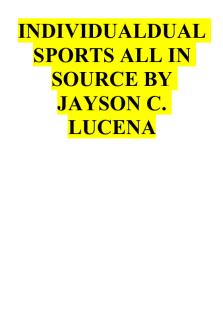MGMT1003 Dual Concern Model Task PDF

| Title | MGMT1003 Dual Concern Model Task |
|---|---|
| Course | Strategic Career Design |
| Institution | Curtin University |
| Pages | 4 |
| File Size | 191.2 KB |
| File Type | |
| Total Downloads | 114 |
| Total Views | 150 |
Summary
Dual Concern Model Task for the team assessment 3...
Description
MGMT1003 Strategic Career Design Module 8: Working with Others Team Project Activity: The Dual Concern Model This completed document needs to be included in the Team Assessment Report – one copy per report.
The Dual Concern Model asserts people’s conflict management styles are based on two dimensions of assertiveness and cooperativeness, which are differentiated into five conflict-handling modes – Competing, Collaborating, Compromising, Accommodating and Avoiding. There are positioned along two dimensions or axes: (1) Assertiveness, the extent to which the individual attempts to satisfy his/her own concerns, and (2) Cooperativeness, the extent to which the individual attempts to satisfy the other person’s concerns. The diagram below illustrates where each mode sits on the axes:
https://study.sagepub.com/lishman2e/student-resources/chapter-15/case-studies-activities
Whilst a person may have a leaning towards one mode, different modes can be drawn upon dependent on the situation (Lishman, Yuill, Brannan and Gibson, 2020). A core issue is self-awareness and understanding how you tend to react to adopt a different mode as the situation demands. 1. Self-reflection – developing your self-awareness which is a key conflict management skill. (10 minutes) a. Do you generally handle conflict with an emphasis on cooperation or assertiveness? Cooperation – Can lead to more effective and productive teamwork. b. Would you prefer to adopt one mode more so than the others? Why or why not?
Collaborating – Effective collaboration makes for better teamwork. Finding common ground works better in the long run. Combining different ideas and perspectives together can lead to more creativity and productivity. c. Describe a conflict situation whereby you adopted a conflict-handling mode which was either suited or inappropriate to the situation. Example of conflict (Compromising): Group assignment Half of the group agreed on one idea, whereas the other half agreed on a different idea. We used the conflict-handling mode of compromising to bring our ideas together and find common ground. We ended up merging the two ideas together to create one solid idea. 2. Team Project Activity: Conflict Management using Dual Concerns Model (30 minutes) Organise into your Team Project groups and complete the following: a. Share your responses to the self-reflection questions. Are there any similarities and / or differences to how some group members handle conflict, and could these affect the teamwork efficacy? b. Identify situations where adopting a particular conflict-handling mode may be appropriate Competing Emergency – quick decision-making is vital.
Compromising To achieve a temporary settlement to a complex problem.
Collaborating To develop a sense of commitment by incorporating the concerns of all team members.
Avoiding The issue is trivial.
Accommodating The issue is of greater importance to others.
3. Dual Concern Model Task (30/45 mins). Each Team Assessment group will now be allocated one of the 5 conflict-handling modes – competing, collaboration, compromising, accommodating or avoiding (two groups may share the same one if necessary). a. write a brief business conflict role play exemplifying the conflict-handling mode allocated (5 mins). Option 1 b. present the conflict role-play to the class. c. each group will now have 10 minutes to attempt to problem solve this conflict by adapting their allocated conflict-handling mode. Each conflict management mode will be showcased to the class by a group member/s ‘entering’ the role-play to diffuse and improve the situation. Once complete, the group will briefly explain the objectives of the conflict management strategy and identify its strengths and weaknesses. Objectives: Strengths: Weaknesses: d. Group reflection question: identify three most important lessons your team learnt about the conflict management. Option 2 (online / time constraints.) b. read / post the conflict role-play out to the class (5 mins) c. each group will now have 10 minutes to attempt to problem solve this conflict by adapting their allocated conflict-handling mode. Each conflict management mode solution will be read / posted to the class by a group member. Once complete, the group will briefly explain the objectives of the conflict management strategy and identify its strengths and weaknesses. Objectives: Strengths: -
Quick
Weaknesses: -
Only solves the problem short-term. It doesn’t really solve the underlying problem No one is ever 100% satisfied
d. Group reflection question: identify three most important lessons your team learnt about the conflict management.
Remember: include one copy of this document in the Team Assessment Report....
Similar Free PDFs

MGMT1003 Dual Concern Model Task
- 4 Pages

Makalah audit going concern
- 18 Pages

Dual rate
- 3 Pages

espacio dual
- 2 Pages

Contoh opini going concern
- 1 Pages

Task 1 - Email Model Answer v2
- 2 Pages

ISA-570-Revised Going Concern
- 26 Pages

Moffitt’s Dual Taxonomy Theory
- 3 Pages

Individual and dual sports
- 6 Pages

Caso clínico: \"Patología dual\"
- 4 Pages

Metodo DUAL Simplex
- 6 Pages

Module 1 Dual Stunts
- 12 Pages

Dual space - Apuntes 3
- 11 Pages

Individual Dual Sports
- 166 Pages
Popular Institutions
- Tinajero National High School - Annex
- Politeknik Caltex Riau
- Yokohama City University
- SGT University
- University of Al-Qadisiyah
- Divine Word College of Vigan
- Techniek College Rotterdam
- Universidade de Santiago
- Universiti Teknologi MARA Cawangan Johor Kampus Pasir Gudang
- Poltekkes Kemenkes Yogyakarta
- Baguio City National High School
- Colegio san marcos
- preparatoria uno
- Centro de Bachillerato Tecnológico Industrial y de Servicios No. 107
- Dalian Maritime University
- Quang Trung Secondary School
- Colegio Tecnológico en Informática
- Corporación Regional de Educación Superior
- Grupo CEDVA
- Dar Al Uloom University
- Centro de Estudios Preuniversitarios de la Universidad Nacional de Ingeniería
- 上智大学
- Aakash International School, Nuna Majara
- San Felipe Neri Catholic School
- Kang Chiao International School - New Taipei City
- Misamis Occidental National High School
- Institución Educativa Escuela Normal Juan Ladrilleros
- Kolehiyo ng Pantukan
- Batanes State College
- Instituto Continental
- Sekolah Menengah Kejuruan Kesehatan Kaltara (Tarakan)
- Colegio de La Inmaculada Concepcion - Cebu

